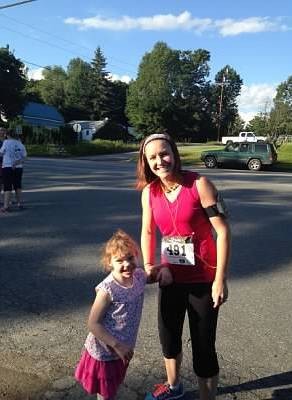SUBMIT. VOTE. WIN.
ENTRY FROM: The Top 100 Health Promotion Professionals
Nominee: Abigail DiPasquale
Making Wellness Work at the Workplace!
I have been in the field of health promotion and wellness for the past 16 years, the last 10 as a Health Promotion Coordinator with the Maine Municipal Employees Health Trust, a division of the Maine Municipal Association. This non-profit health insurance company serves municipalities and quasi-municipalities across the state of Maine. The company itself is about 120 employees, however our client base is over 20,000 individuals.

Professional Development
I received my Masters in Public Health from Southern Connecticut State University after falling in love with the field of health and wellness as an undergraduate at the University of Maine. My experience at a woman’s health clinic set the course for my current profession. As a Master Certified Health Education Specialist (MCHES), I maintain rigorous academic and professional CEUs. I rely on WELCOA’s webinar and certification series to enhance my knowledge base. I am proud to say that I am a WELCOA Faculty member and continue to view this as the most valuable asset to my current profession.
Demonstrated Success
Our program has been growing by leaps and bounds over the past 10 years, since I came on board. We have more than doubled our wellness program offerings, from 31 programs to over 85, and our participation has increased by 117%! However, even with the increase in our participation rates, I felt we were disconnected with our clients- often relaying information through a class or program and then leaving in the hopes that one or two would follow-through and make a positive lifestyle change. This led to the introduction of a pilot program with one of our medium-sized towns to offer a certified health coach for interested employees. This program is nearing the end of year one, and preliminary data is encouraging, yet not yet complete.
Working in collaborating with the wellness committee at the Town, we created a program that would provide monetary incentive to employees who chose to take their wellness programming to the next level and enroll with a health coach. The Town Manager and Selectpersons were open to the implementation of this pilot program and encouraged employees to take this next step. 62% of eligible participants enrolled and have continued on with this program. Clients worked with their coaches to complete health assessments, identify concerns, establish goals and create ongoing relationships. Each client had an individualized plan, with goals and steps specific for what they wanted to achieve. Goals ranged from creating a budget, completing a half marathon, getting A1C levels in range, losing weight, and quitting smoking- just to name a few. I met each of my clients where they were in regards to health and fitness, instead of telling them where they should be- this was a major shift in how we offer wellness programs!
I had face to face meetings with each of my clients every other month and followed-up with phone or emails in between sessions. Those who needed a little more support to stay motivated were checked in with more frequently than those who were comfortable with doing it more or less on their own. As I mentioned, preliminary results are encouraging! Since each client had very individual and unique goals, most of the data at this point is qualitative. I did have one individual quit smoking, after 45 years and multiple quit attempts, he has been quit for 6 months currently and is showing great progress and motivation to stay quit. We know that smokers, on average, cost employers an additional $6,000/year and have about 40% higher healthcare costs, this can represent huge savings for both the employee and employer! Another client completed her first half marathon- just in time for her 50th birthday! The results continue to impress me and I could share more than thirty stories just like this. The success of this program will continue to be evaluated and adjustments made to enhance the program as we proceed. This program has continued to change both employee behavior and the culture of this workplace for the better.
Leadership
When I first graduated from college, I was a closet smoker and detested exercise. I quickly learned that in order to help others, I needed to help myself. I quit smoking by putting my sneakers by the door and anytime I wanted to smoke, I would lace up my shoes and run till I felt the cravings diminish. This coping mechanism began my love for running and is the reason I am currently training for my first marathon. This personal experience with my own health struggles has made it easier to relate with my clients about their health struggles. Being “real” and meeting clients where they are is key to being a good leader. Being a leader in the field is a result of being a knowledgeable and approachable resource for our members. Staying up to date with current trends through reading scientific articles and continuing education is difficult but key to making yourself a leader in the profession.
Innovation
Supporting a lifestyle that promotes health and wellbeing does not come easily for many employers. It is a struggle to balance the bottom line, with happy and healthy employees. I have approached wellness as a way to improve employee morale and the company’s bottom line. Through the introduction of workplace audits, I have been able to target the systems level of wellness. These audits have resulted in the implementation of fitness rooms, point of decision signage, stretch breaks and changes to vending machines affecting hundreds of employees. One of my most successful wellness programs has been my “How Full is Your Bucket” class that has reached over 1,000 people in the past 4 years. This program has resulted in a cultural shift in over 60 workplaces to recognize the strengths of employees and coworkers and use that positive recognition as a spring board for good health and stress reduction.
Compelling Vision
The field of health and wellness is changing more rapidly now than it has since its inception. With health care becoming a retail commodity and “experts” springing up on every blog and social media platform, I see the biggest threat to Health Promotion being accuracy and collaboration. Many wellness providers operate in silos and do not know what other agencies or professionals are doing; this disjointed approach to wellness creates confusion and inefficiency. In my role, I will continue to seek out partnerships with other professionals and related organizations to reduce redundancy and improve the accessibility of health resources to our members and their families. Continuing to pursue best practices and remain current in scientific research are key to remaining relevant and serving as a true leader in wellness.
You can vote as often as you like. You may vote once per hour per entry.
When you come back, use the search function to find this entry.
100
You can vote as often as you like. You may vote once per hour per entry.
When you come back, use the search function to find this entry.


Comments are in order of newest to oldest
Post a Comment